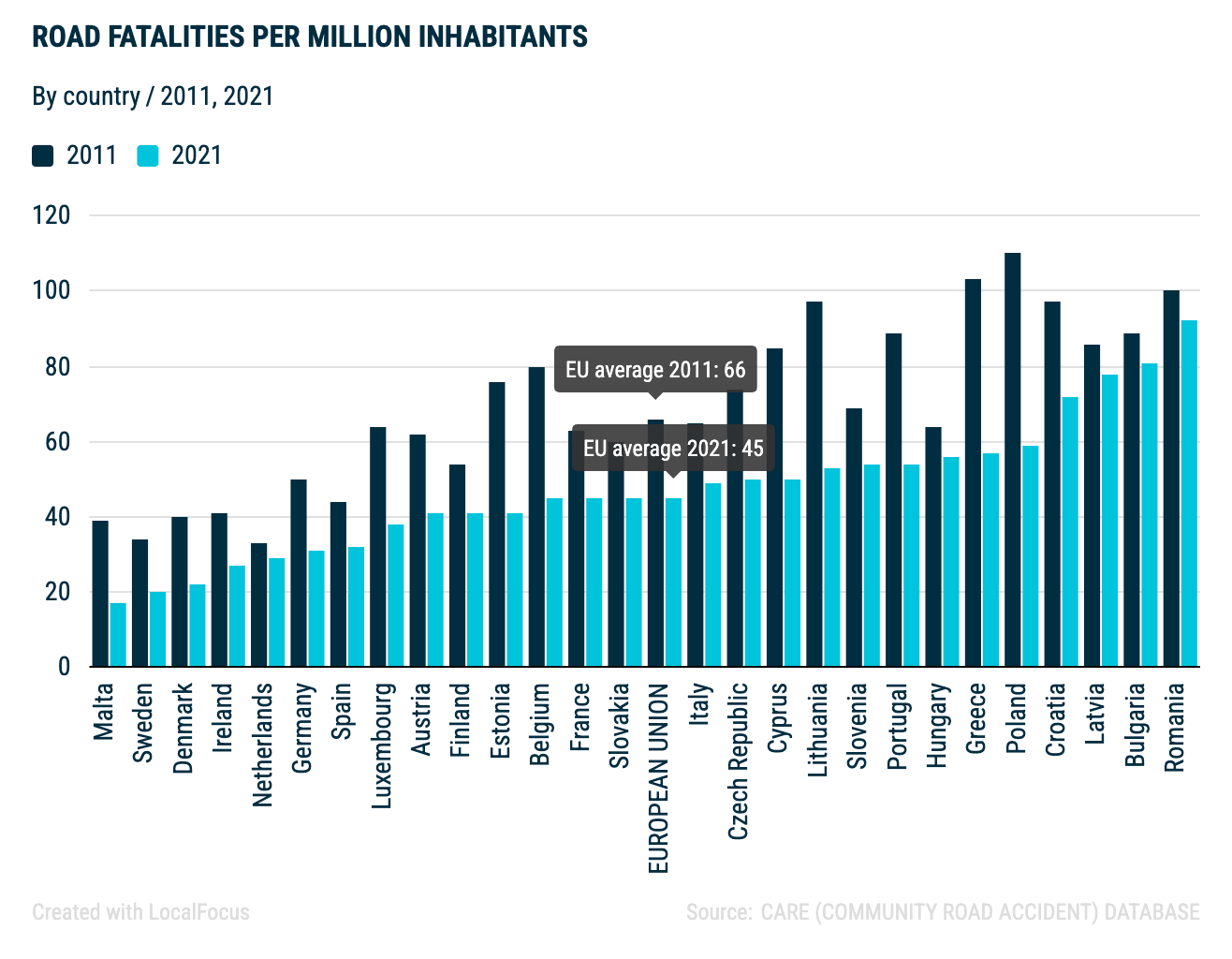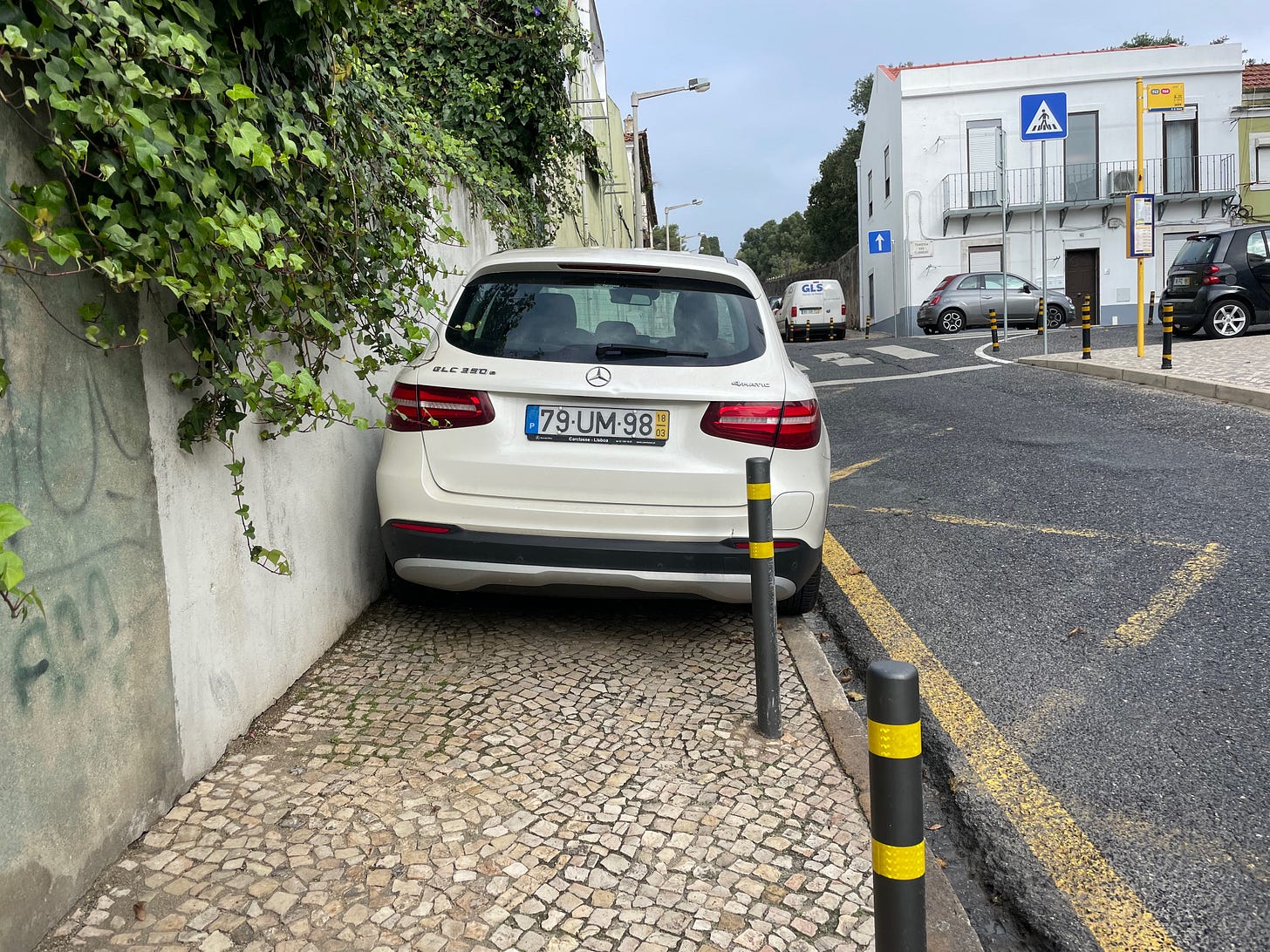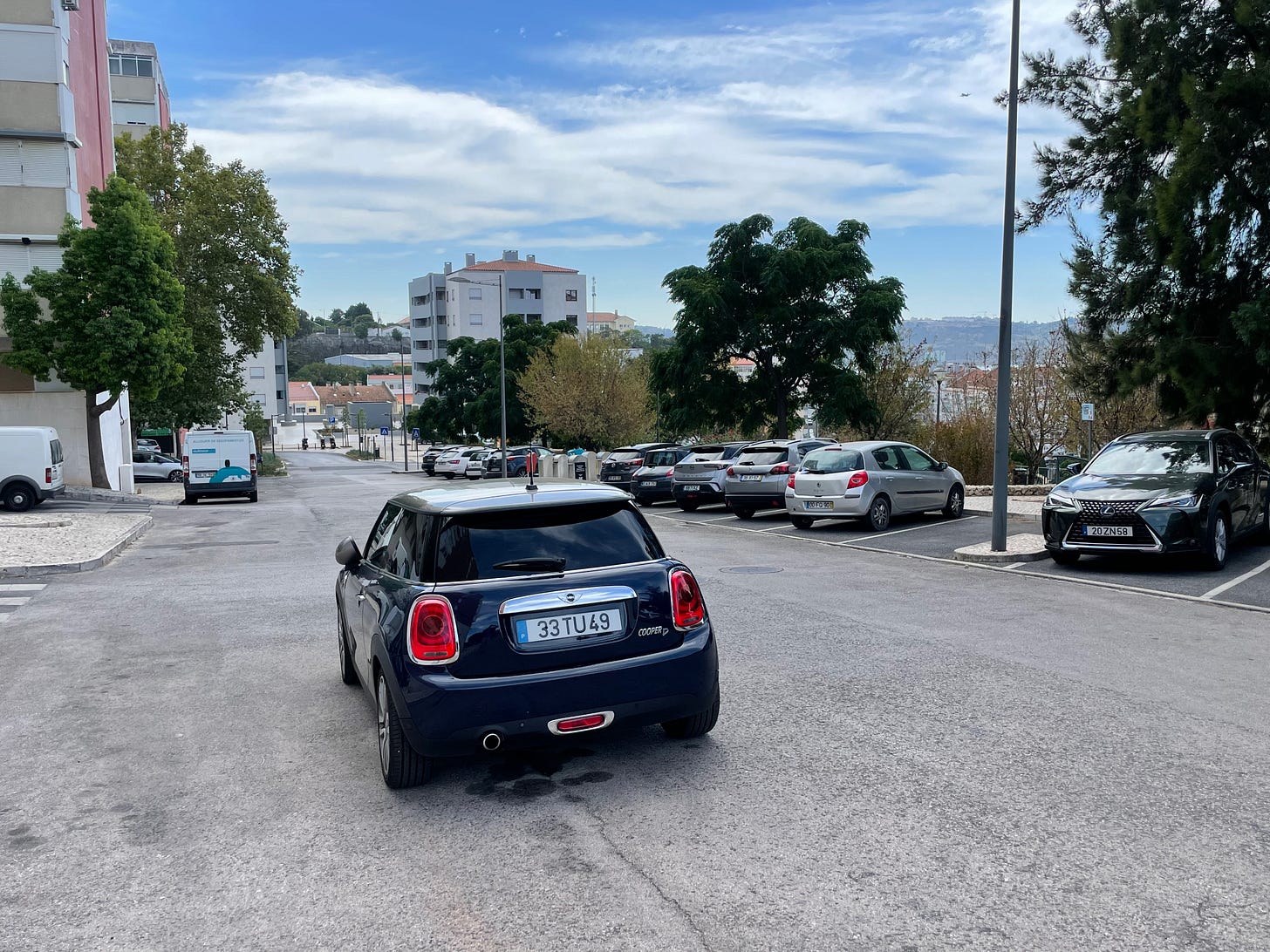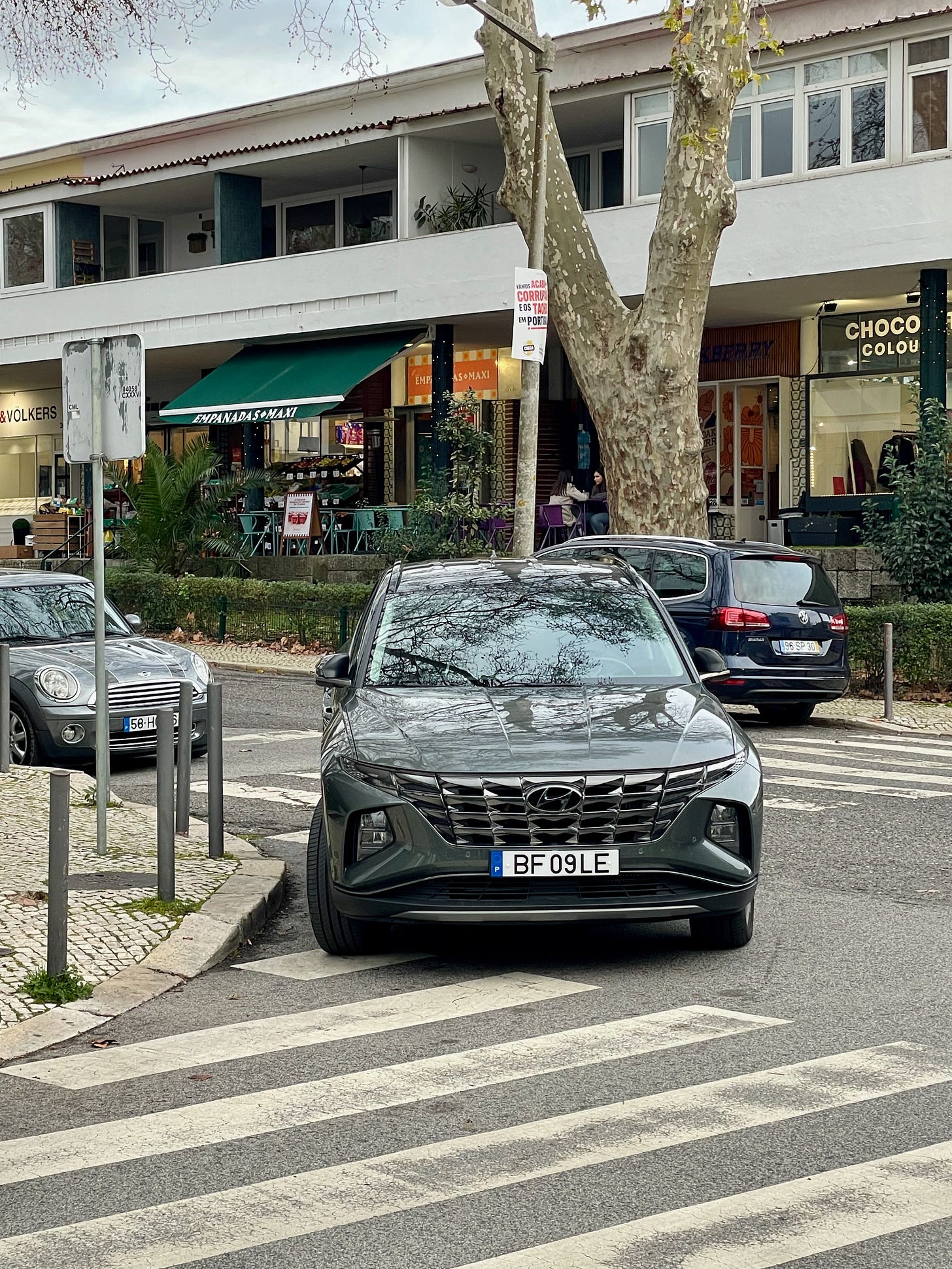João Is Driving in His Car, and European in Your Pants
Why I am so scared of Portuguese drivers
Last year, I made up a joke about Portuguese drivers. It goes like this: Did you know that when you apply for a driver’s license in Portugal, you have to submit to a psychological exam? When the result comes in, either you’re certified as sane or you’re given a driver’s license.
I have mostly stopped telling this joke, because over the past few months, I have realized that Portuguese drivers aren’t all crazy, and they’re not crazy in all ways. But they sure do seem pretty crazy sometimes. In this essay, I want to talk about driving—and its wicked stepsister, parking—here in Portugal, but first I’ll try to center the discussion in the context of European drivers in general.
Europe is the safest region of the world in which to travel by road. On average, in the European Union, only 45 people per million inhabitants die in traffic-related accidents every year. (The corresponding number in the USA is 128; in China, it is 174; Japan, impressively, comes in at only 21.1) The following graphic shows how the various EU member states compare in traffic fatalities, as well as how much they have improved over the past ten years (data from 2011 and 2022).
I don’t know whether it surprises you that Italy is right at the EU average, neither high nor low. I surprised me when I first learned it, since I have always thought of Italian drivers as the most chaotic in Europe (think Roberto Benigni in Night on Earth). But that was before I started driving in Portugal.
Recently, my ex, Liza, and I spent a year traveling by car around Europe, putting in 33,000 km (20,000 miles) around 10 countries in only a year. Why we did this is a story that I will tell another time. Let me just say that during this year, we developed some opinions about drivers in different countries. For example, we coined the term “French Swipe” for a maneuver that French drivers seem to like to do on the motorway: Imagine a six-lane highway, three lanes in each direction. If you are in the middle lane, a French driver will likely zoom up behind you, move over to the left lane, overtake, and then, nearly cuffing your front bumper, slide across to the right lane. If you are really lucky, you will also be treated to some world-class mouth puckering and a short lecture on traffic priorities delivered entirely in mime.
A friend recently asked me to summarize my perception of the different national driving styles in Europe, and I said something like this: German drivers are law-abiding, French drivers are arrogant, Italian drivers are aggressive, Spanish drivers are surprisingly cooperative, and Portuguese drivers are just insane. Note that this is a caricature, and not to be taken too seriously. But if you look at the fatality statistics for Spain and Portugal above, you will see that Portugal has 70% more road fatalities than next-door Spain, down from fully double a decade earlier.
Where do these national differences come from? I am certain that the answer is extraordinarily complex and has to do with factors such as cultural priorities, national self-image, education, wealth, infrastructure, industry standards, administrative competence, and political policy. Sweden, which is one of the very safest countries in the world to drive in, came up with a national road policy in 1997 with the rather unfortunate name Nollvisionen, or Zero-Vision, sounding an awful lot like self-parody (which, sadly, is illegal in Sweden). The idea of Nollvisionen was to adopt the goal of having zero traffic fatalities. To my surprise, this charmingly naïve Swedish notion actually caught on, and several European countries, the European Commission, and even several cities in the US have adopted the “Vision Zero” framework (as it is called, slightly more felicitously, in English).
Not Portugal, though. In the essay “Let’s Register Our Car in Portugal! How Hard Can It Be?”, I told the story (described as both “terrifying” and “hilarious” by readers) of how I got my car registered here, but I didn’t actually say anything about what it’s like to use a car in Portugal. Let’s just say that if you have issues with high blood pressure, you might not want to spend much time on the road here.
Essentially, it seems to me that Portuguese drivers (and importantly, the male drivers are at least four times as bad as the female drivers) are (a) uninterested in any rules of traffic, and (b) completely oblivious to risk. Every day, I see people driving incredibly fast, running red lights, and making maneuvers that are terribly risky, almost as though there were daring someone to crash into them, or arrest them.
Certainly, it has gotten better. When I first lived in Portugal back in the 1990s, I remember one time I was driving down a highway—this was before the new highway system was built, when a major road could still be one lane in each direction—and I came up behind a truck. I slowed down, but the person behind me decided to overtake. While he was in the lane with the oncoming traffic, the driver behind him decided to overtake as well—and overtook the car that was already overtaking by driving on the opposite shoulder of the road! Imagine if a driver had come from the other direction and seen three lanes of traffic heading right at them.
Luckily, such maneuvers are no longer as frequent, since Portugal now has a gloriously well-maintained and relatively underused private highway system. I think that it’s underused mostly because it’s terribly expensive—much like the French highways, though I can assure you that these are not underused. I always take the private highways in Portugal when I can, because I am happy to pay a premium to avoid Portuguese drivers.
But in fact, the thing that bothers me most about Portuguese drivers is what they do when they stop driving—that is, how they park. I have illustrated this piece with some photos that attempt to convey the particular Portuguese genius for independent thinking and creative self-expression in parking cars. Here in Lisbon, at least, you can find cars parked on the sidewalk (completely blocking passage for pedestrians), parked right on the corner in an intersection (making turning the corner nearly impossible), or even parked right in the middle of the street. It’s almost as though drivers were playing a reversed game of “musical chairs”, in which whenever the music stops, you simply jump out of your seat.
And yet, not everything about Portuguese driving is bad. One of the reasons I have stopped telling my joke (besides the fact that it’s not a very good one) is that I have noticed something quite positive in the drivers here: They can be very kind to pedestrians wishing to cross the street, and to cars trying to enter the flow of traffic. I am amazed at how often I approach a pedestrian crossing (I find the term “zebra crossing”, so common in European languages, quite funny for its apparent misunderstanding of ungulate migration patterns) and see a driver not only slow to a stop, but also make a graceful little hand gesture ushering me across the street. Similarly, in heavy traffic, I am surprised at how often a car will offer to create space for a driver on a side street hoping to join the fun. It’s as though the drivers here were Dr. Jekyll in first gear and Mr. Hyde in fifth.
Why might that be? My understanding of Portuguese culture is not yet very highly developed, but I will take a stab at explaining these two patterns in terms of other behaviors I have observed here. I would say that the reckless, risky driving corresponds to the macho selfishness that many Portuguese men exhibit, which in turn comes from being pampered from childhood in what is ultimately a very sexist society. Boys seem to be given a great deal more latitude, and power, than girls here. Meanwhile, the consideration shown for people who are trying to get across the road maps pretty well onto the we’re-all-in-this-mess-together attitude that I have observed in many contexts here, including the way bureaucrats operate. Ultimately, I see Portugal as a relatively collectivistic, though still sexist, society.
While I’m trying here to portray my fear of Portuguese traffic in a light and humorous way, it’s important to remember that we are actually talking about a matter of life and death. I remember one Friday, many years ago, when I first lived in Lisbon. I had a colleague named Francisco, who was a very sweet young guy. I had asked him what his plans were for the weekend, and he had said he had a friend coming up from the Algarve to spend the weekend. At the end of the workday, I noticed that Francisco was still there, just sitting in a chair, staring into space. I sat down and asked him if something was wrong.
He looked at me with blank amazement on his face and said, “My friend… died. He was driving up to Lisbon, and he crashed his car. He’s dead.” We sat, staring at each other, and then I hugged him and took him out for a beer, just to let him talk. But what is there to say? Sometimes we drive ourselves to a place where nothing more can ever be said.
Maybe I shouldn’t make fun of the Swedes and their Zero-Vision. It would indeed be a wonderful world if nobody had to die on the road.













Headline made my inner middle schooler snort milk out her nose….
As someone who has driven in Italy a couple of times (never in the big cities - I'm not insane), I have actually been surprised that it wasn't *as bad* as I expected. It is true, though, what they say about Italian speed limits - they are only a suggestion (for Italians). I was very startled the first time a car sped up behind me as I was changing lanes and started flashing their lights at me, basically saying move the hell over. Apparently it is the car version of the pervasive Italian hand gestures you see in everyday conversation.
Once, in Puglia, while driving back on the highway to the smaller city Lecce at midnight after a four hour eating fest in the courtyard of a 500 year old olive orchard, I came upon a stand still traffic jam. While we sat waiting, I started to see the Italians put their cars in park, get out and begin socializing with each other. Some even pulled food and drink out of the their cars. It was so startling that I burst out laughing. I also looked at my passengers and said, "Well, when in Rome," and we also got out. Of course, just our luck, it was within 30 seconds of doing so that I saw brake lights and everyone ran to their cars. Needless to say, I have never experienced anything like that here in New York.